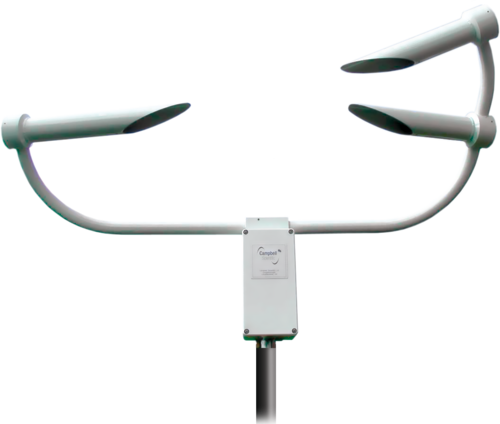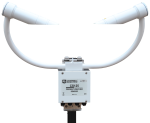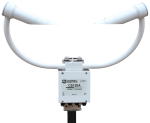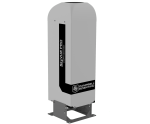
| Services Available |
|---|
概览
PWS100 是一款激光类型的传感器,测量降水和能见度,精确测定空气中雨滴的大小和速度。可以用于道路、机场和海洋等应用中的气象站。PWS100 使用高级的测量技术和算法来计算单个降水颗粒的类型。
优势与特点
- 识别多种降水类型,包括:细雨、雨、雪、冰雹、霰(雪丸)
图像

技术说明
PWS100 当前天气现象仪是一款激光类型的传感器,测量降水和能见度。可以用于道路、机场和海洋等应用中的气象站。PWS100 使用高级的测量技术和模糊逻辑算法来测定单个降水颗粒的类型,包括精确的大小和速度,以及接收到的信号结构。辅助测量空气温度和相对湿度提供改进的颗粒分级。
PWS100 包含数字信号处理器(DSP)外罩单元,连接到包含一个激光头和两个传感器头的传感器臂上。 每个传感器头以20°离轴对准激光单元的轴,一个在水平平面上,另一个在垂直平面上。PWS100 到货时附有固定托架,可连接DSP罩到主桅杆或立杆上。
产品规格
| Measuring Area | 40 cm2 per light sheet |
| IP Rating | IP 66 (NEMA 4X) |
| Housing Material | Iridite NCP conversion coated aluminium (RoHS compliant) and hard anodized aluminum |
| Communication | RS-232, RS-422, or RS-485 |
| Baud Rate | Selectable from 300 bps to 115.2 kbps |
| Control Unit | Custom DSP Board |
| EMC Compliance | Tested and conforms to BS EN61326:1998 |
| Dimensions | 115 x 70 x 40 cm (45.28 x 27.56 x 15.75 in.) |
| Weight | 8 kg (17.6 lb) |
Power Requirements |
|
| DSP Power | 9 to 24 Vdc (or 9 to 16 Vdc with CS215-PWS Temperature and RH sensor) |
| Current Consumption | 200 mA to 1 A |
| Hood Heater | 24 Vac or dc, 7 A |
Optical |
|
| Laser Source | Near-infrared diode, eye safe Class 1M unit output |
| Peak Wavelength | 830 nm |
| Modulation Frequency | 96 kHz |
| Receivers | Photodiode with band pass filters |
| Spectral Response | Maximum spectral sensitivity at 850 nm, 0.62 A/W (0.6 A/W at 830 nm) |
| Lens Check Light Source | Near-infrared LED |
Measurement |
|
| Particle Size | 0.1 to 30 mm (0.0039 to 1.18 in.) |
| Size Accuracy | ±5% (for particles greater than 0.3 mm [0.0118 in.]) |
| Particle Velocity | 0.16 to 30 m/s |
| Velocity Accuracy | ±5% (for particles > 0.3 mm [0.012 in.]) |
| Types of Precipitation Detected | Drizzle, rain, snow grains, snowflakes, hail, ice pellets, graupel, mixed (combination of types above) |
| Rain Rate Intensity Range | 0 to 999.9 mm/h-1 |
| Rainfall Resolution | 0.0001 mm |
| Rain Total Accuracy |
Typically ±10% Accuracy figures are for laboratory conditions with reference particles and standards; accuracy will be degraded for windy conditions, frozen precipitation, and very high rainfall rates. |
| Visibility Range | 0 to 20,000 m (0 to 65,616.8 ft) |
| Visibility Accuracy | ±10% to 10,000 m (±10% to 32,808.4 ft) |
| Visibility Measurement Interval | User-selectable from 10 s to 2 h |
| External Sensors | SDI-12 compatible sensors supported (such as the CS215-PWS Temperature and RH Probe) |
| Detection Threshold | > 0.02 mm hr-1 |
| Accumulation Accuracy | ±10% |
兼容性
Please note: The following shows notable compatibility information. It is not a comprehensive list of all compatible products.
数据采集器
| Product | Compatible | Note |
|---|---|---|
| 21X (retired) | ||
| CR10 (retired) | ||
| CR10X (retired) | ||
| CR200X (retired) | ||
| CR206X (retired) | ||
| CR211X (retired) | ||
| CR216X (retired) | ||
| CR23X (retired) | ||
| CR295X (retired) | ||
| CR300 (retired) | ||
| CR3000 (retired) | ||
| CR310 | ||
| CR500 (retired) | ||
| CR5000 (retired) | ||
| CR510 (retired) | ||
| CR6 | ||
| CR800 (retired) | ||
| CR850 (retired) | ||
| CR9000 (retired) |
下载
PWS100 Present Weather Viewing Software v.2.6.1 (32 MB) 24-01-2012
Designed to complement the PWS100 the Present Weather Viewer provides a simple yet comprehensive interface showcasing many of the capabilities of the PWS100 whilst providing easy configuration of key sensor features.
常见问题解答
PWS100: 7
展开全部收起全部
-
The Present Weather Viewer is available for download from the Downloads section of the PWS100 product page.
-
Yes. For in-situ calibration by the user, use the PWC100 (Calibrator for PWS100). There is a separate PWC100 instruction manual.
-
The basic processing current of the PWS100 is <200 mA at 12 V supply. However, the sensor has two levels of heating available. One set of heaters—known as the dew heaters—prevents condensation on the main lenses of the sensor. When these sensors turn on, the current usage increases to approximately 500 mA at 12 V. A current drain of 1 A is the worst case scenario if the input supply to the sensor drops to the minimum of approximately 9 V (the current drain increasing at lower voltages).
By default, the dew heaters turn on all the time and the main hood heaters are off. The dew heaters can be turned off by the user.
The main hood heaters run from a separate power supply and consume 7 A at 24 V when fully on. The main hood heaters only need to be used when icing conditions are likely.
-
The Present Weather Viewer does not have a save function for the data. The software is designed as a tool to view current data coming from the fields included in the default message of the PWS100. The Present Weather Viewer can also be used to configure the sensor and access the built-in menu system.
To read, store, and collect data, connect the PWS100 to one of the data loggers or query the sensor directly.
-
The PWS100 measures the size and velocity of particles in the air. It can provide precipitation rate and water equivalent accumulation, but it is primarily used to report present weather codes, as defined by the World Meteorological Organization and National Weather Service, and particle size and velocity distributions. The PWS100 cannot measure snow depth, as it identifies water droplets in air.
-
Unless the rain gage is poorly sited, the PWS100, similar to most sensors of this type, is less accurate measuring precipitation accumulation than a conventional rain gage.
The PWS100, because of its high sensitivity, is more accurate at detecting the start, end, and totals of very fine rainfall events. In addition, the PWS100 does not experience the evaporation issues that a rain gage does.
-
The PWS100 measures visibility by the amount of light that scatters off the particles in the sensing volume, and thus, it cannot measure visibility reduction because of absorption. However, because reduction of visibility by airborne particles is dominated by the scattering effect, the PWS100 is able to measure reduced visibility because of sand, dust, and smoke. The value, however, is less accurate and reads slightly higher for blowing dust, sand, or smoke than for precipitation.
案例研究
The Channel Tunnel (or Chunnel) connects the United Kingdom with France. It is actually a......阅读更多



